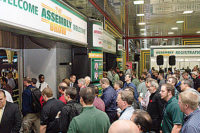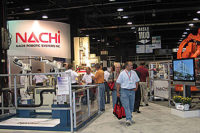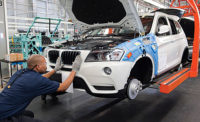Creating and sustaining a culture of continuous improvement requires a commitment from management to lead by example.
That was the advice of Richard Morris, vice president of product integration at BMW Manufacturing Co. in Spartanburg, SC, during his keynote address to kick off the third annual ASSEMBLY Show in Rosemont, IL, in October.
“Quite often, we hire lean consultants or trainers, and we expect that they’re going to change things,” Morris told a capacity crowd of more than 250 manufacturing professionals. “The fact is, change management is the job of the organization’s leadership.
“The Germans have a saying, ‘The fish stinks from the head down,’” continued Morris, who has been with BMW for 22 years. “As leaders, you cannot outsource change. It must be done through your actions—setting good examples for your team and convincing them that change is the right thing for the organization and, more importantly, the right thing for them.”
Getting people to change is not easy, Morris conceded. By their nature, leaders are creative and dynamic, and they hate routine. Conversely, followers thrive on routine. Thus, change management is inherently problematic.
“People who hate routine must convince people who are fixed in their routines to [adopt a new routine],” Morris explained. “And they must do that by leading and living the new routine—the very thing want to avoid. Worst of all, they must do that until the new routine is accepted as the new standard, and that process takes a long time. If the leader gets bored and moves on too early, people will return to their old routines and sustainable change is lost.”
Six Actions
During his talk, Morris outlined six actions that can help sustain a culture of continuous improvement:
- Leading by example.
- Work organization.
- Standard work.
- Process observations.
- Coaching.
- Standard work for management.
Process observations are particularly critical, Morris said. At BMW’s Spartanburg assembly plant—the largest of the automaker’s factories worldwide—plant managers visit the shop floor daily at a standard time to meet with supervisors and team leaders. Based on a standard status report of key indicators, such as quality, cost, time and safety, the managers choose a process to observe.
When observing a process, managers introduce themselves to the people doing the work and explain what they’re doing and why they’re doing it. The managers then observe several cycles of the process and document any deviations to established standards. They also note any ideas for improving the workstation or the process.
“In the beginning, most of the findingswill be around 5S and housekeeping, but as the process matures, the team will focus more on safety, quality and efficiency opportunities,” said Morris. “Most importantly, the leadership team should talk to the people who are performing the process and ask what they think about it and what they would do to improve it. Leaders should also ask how they could help their workers do a better job.”
Next, managers convene with the area supervisor and team leader to exchange findings. “Document those things you think are valuable improvements, no matter how big or small, and always define who is going to do what by when,” advised Morris. “On the next visit, we always start by following up on the points raised at the last meeting.”
If managers observe that workers aren’t following a standard procedure, they should always ask why. “Quite often, you’ll find there was a good reason,” Morris said. “Perhaps there’s a safety or quality problem, or they’ve learned to eliminate a wasted step. If what they’re doing is determined to be better than the standard, then the standard should be updated and the rest of the team should be retrained.”
Morris emphasized that standard work is just as important for management as it is for assemblers.
“Like most managers, I’m very busy. It’s easy to lose track of the day,” he said. “It wasn’t until I defined standard work for myself that I made better use of my time and ensured that I had time to be where value was being created, to observe processes, and to coach.
“We’ve defined standard work for our entire leadership team. We defined a common two-hour block each morning dedicated to process observations and coaching. Each of us has a schedule as to what team we will visit that day, and because we do it all in the same two-hour time block, there are no meetings during this time. Those two hours each morning have made the biggest impact on our continuous improvement efforts.”
Preceding the keynote, senior editor Austin Weber announced that the 2015 Assembly Plant of the Year Award went to Polaris Industries Inc. and its state-of-the-art motorcycle factory in Spirit Lake, IA.
“Whether we create markets and trends or simply stay ahead of them, we expect to set the standard rather than follow it,” said Scott Wine, chairman and CEO of Polaris in a video message accepting the award. “We strive to deliver the next big thing that is and will be hot, rather than what was desired. Being honored as the 2015 Assembly Plant of the Year is a testament to the success of the Polaris way.”
Thousands Attend Show
The 3rd Annual ASSEMBLY Show was bigger and better than last year’s show. The event featured 247 exhibitors occupying nearly 59,000 square feet, a 16 percent increase over 2014. Some 6,684 manufacturing professionals registered for the event—a 5 percent increase from 2014—and 4,263 (64 percent) attended.
Many exhibitors deemed the show a huge success. “We had a great show. The attendees were plentiful, interested and motivated,” said Phil Sponslor, president of Orbitform. “This is the only trade show we invest in due to its continuous success.”
“This year’s show was better than last year,” added Micah Durham, national sales manager for Schleuniger Inc. “There was more energy on the first day, and there were clearly more attendees on the show floor.”
Indeed, the show was such a success that 70 percent of exhibitors have already renewed their booth space for the 2016 show, which will take place Oct. 25-27 back at the Donald E. Stephens Convention Center in Rosemont.
“We are thrilled with the response from the industry and thank the exhibitors, attendees, speakers and press who made this such a worthwhile event for the third year in a row,” said Tom Esposito, publisher of ASSEMBLY Magazine. “The ASSEMBLY Show offered a comprehensive educational program with expert speakers; exhibitors showcasing their latest products and solutions; and an expanded networking environment that provided opportunities to exchange valuable ideas with colleagues, friends and peers. It is my sincere hope that the show left our attendees better informed, better connected, and better prepared to meet the challenges they face as assembly professionals.”
Besides the exhibits, the show featured 20 educational sessions that were held in theaters set up on the exhibit hall floor. Presentations were given by Panasonic Assembly Tools, Desoutter Industrial Tools, Henkel Corp., 3M Industrial Adhesives, LACO Technologies Inc., Nordson EFD, Festo Corp., Red Viking, DE-STA-CO, Flex Craft, Panduit Corp., Balluff Inc., Afag Automation, Stäubli Corp., Master Pneumatic Inc., The Arthur G. Russell Co., and OPS Solutions. In addition, the editors of ASSEMBLY magazine organized presentations on capital spending, industry trends, and high-speed automated assembly.
Three four-hour workshops were held on Oct. 27, before the show opened. The workshops covered additive manufacturing, methods for mixed-material assembly, and design for manufacture and assembly.
Next year’s ASSEMBLY Show will be held Oct. 25-27, 2016, at the Donald E. Stephens Convention Center in Rosemont, IL. For more information, visit www.theassemblyshow.com.
Miss a Session? Catch it on Demand
The ASSEMBLY Show conference program included 29 hours of educational sessions covering topics ranging from power tools to vibratory feeders to automatic guided vehicles.
If you couldn’t attend the show or if you missed a session, no worries! Seven presentations were broadcast live as webinars and are now available for viewing on demand:
Cordless Technology Takes Error-Proofing to New Levels, Kevin Reiland, Panasonic Assembly Tools.
Adhesive and Tape Technologies to Replace Mechanical Fasteners, Shari Loushin, 3M Industrial Adhesives and Tapes.
Technology Developments in Liquid Optically Clear Adhesives for Display Lamination Applications, Kelly Nelson, Henkel Corp.
Squeezing More Productivity and Profit From Your Harness Assembly, Patrick Ryan, Panduit Corp.
Advances in Flange and Thread Sealant Technology and Applications, Michael Feeney, Henkel Corp.
2016 Capital Equipment Spending Outlook, John Sprovieri, ASSEMBLY Magazine.
2016 State of the Profession Report, Austin Weber, ASSEMBLY Magazine.
To view these presentations, visit www.theassemblyshow.com/broadcastlive.










